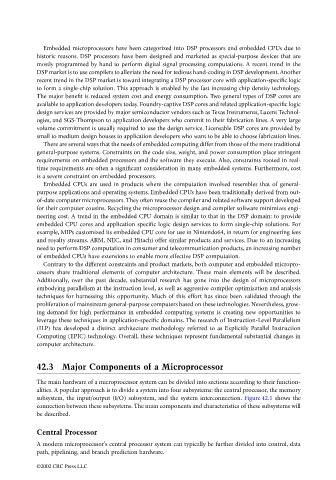Page 1123 - The Mechatronics Handbook
P. 1123
Embedded microprocessors have been categorized into DSP processors and embedded CPUs due to
historic reasons. DSP processors have been designed and marketed as special-purpose devices that are
mostly programmed by hand to perform digital signal processing computations. A recent trend in the
DSP market is to use compilers to alleviate the need for tedious hand-coding in DSP development. Another
recent trend in the DSP market is toward integrating a DSP processor core with application-specific logic
to form a single-chip solution. This approach is enabled by the fast increasing chip density technology.
The major benefit is reduced system cost and energy consumption. Two general types of DSP cores are
available to application developers today. Foundry-captive DSP cores and related application-specific logic
design services are provided by major semiconductor vendors such as Texas Instruments, Lucent Technol-
ogies, and SGS-Thompson to application developers who commit to their fabrication lines. A very large
volume commitment is usually required to use the design service. Licensable DSP cores are provided by
small to medium design houses to application developers who want to be able to choose fabrication lines.
There are several ways that the needs of embedded computing differ from those of the more traditional
general-purpose systems. Constraints on the code size, weight, and power consumption place stringent
requirements on embedded processors and the software they execute. Also, constraints rooted in real-
time requirements are often a significant consideration in many embedded systems. Furthermore, cost
is a severe constraint on embedded processors.
Embedded CPUs are used in products where the computation involved resembles that of general-
purpose applications and operating systems. Embedded CPUs have been traditionally derived from out-
of-date computer microprocessors. They often reuse the compiler and related software support developed
for their computer cousins. Recycling the microprocessor design and compiler software minimizes engi-
neering cost. A trend in the embedded CPU domain is similar to that in the DSP domain: to provide
embedded CPU cores and application specific logic design services to form single-chip solutions. For
example, MIPs customized its embedded CPU core for use in Nintendo64, in return for engineering fees
and royalty streams. ARM, NEC, and Hitachi offer similar products and services. Due to an increasing
need to perform DSP computation in consumer and telecommunication products, an increasing number
of embedded CPUs have extensions to enable more effective DSP computation.
Contrary to the different constraints and product markets, both computer and embedded micropro-
cessors share traditional elements of computer architecture. These main elements will be described.
Additionally, over the past decade, substantial research has gone into the design of microprocessors
embodying parallelism at the instruction level, as well as aggressive compiler optimization and analysis
techniques for harnessing this opportunity. Much of this effort has since been validated through the
proliferation of mainstream general-purpose computers based on these technologies. Nevertheless, grow-
ing demand for high performance in embedded computing systems is creating new opportunities to
leverage these techniques in application-specific domains. The research of Instruction-Level Parallelism
(ILP) has developed a distinct architecture methodology referred to as Explicitly Parallel Instruction
Computing (EPIC) technology. Overall, these techniques represent fundamental substantial changes in
computer architecture.
42.3 Major Components of a Microprocessor
The main hardware of a microprocessor system can be divided into sections according to their function-
alities. A popular approach is to divide a system into four subsystems: the central processor, the memory
subsystem, the input/output (I/O) subsystem, and the system interconnection. Figure 42.1 shows the
connection between these subsystems. The main components and characteristics of these subsystems will
be described.
Central Processor
A modern microprocessor’s central processor system can typically be further divided into control, data
path, pipelining, and branch prediction hardware.
©2002 CRC Press LLC

